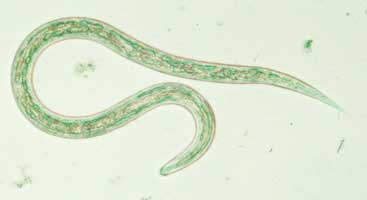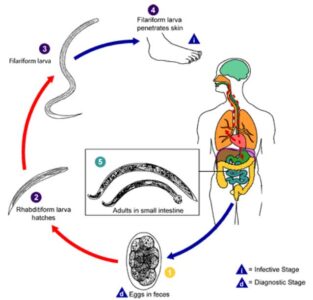Ancyclostoma duodenele is a parasitic nematode worm which is commonly known as old world hookworm. The anterior end of the worm is bent dorsally and thus the name hook worm. It has wide geographical distribution but mostly found in tropical regions. The adult worms live in the small intestine particularly in jejunum, less often in the duodenum and rarely in the ileum. Its lifespan ranges from 3 to 4 years.
Systematic Position
- Phylum: Nematoda
- Class: Chromadorea
- Order: Rhabditida
- Family: Ancyclostomatidae
- Genus: Ancyclostoma
- Species: Ancyclostoma duodenele
Morphological Characteristics
Ancyclostoma duodenele is small, grayish-white cylindrical worm. The female worm is larger than male. In this case, the male is grow up to 11 mm in length while the female can grow up to 13 mm long. The mature female can lay up to 30,000 eggs per day.

The oral aperture is directed towards the dorsal surface. The buccal capsule is lined with cutting organs. These consist of teeth. The posterior extremity of the male is expanded like an umbrella called copulatory bursa supported by chitinous rays.
Life Cycle
Humans are the definitive host. No intermediate host is required. Adult worm lives in the small intestine of infected individuals. Eggs containing segmented ova with four blasomeres are passed in the stool. The eggs when passed with the stool are not infective to human.
The rhabditiform larva (250 µm) hatches from an eggs in the soil in about 48 hours. Moist and warm soil is favorable for hatching. The rhabditiform larva moults twice on the third and fifth day and develops into filariform larva (about 500 µm), the infective stage of hookworm.
The filariform larva casts off its sheath and directly penetrates the skin usually of bare foot. The filariform larva enters into the lymphatics or small venules. It is carried via the right side of the heart into the pulmonary capillaries.
In the lung it enters the alveolar space by penetrating through the capillaries. It then crawls up the bronchi and trachea over the epiglottis to the pharynx and then swallowed and thus pass passes down the oesophagus to the small intestine. A third moulting occurs during migration or entering the oesophagus. The migration time is about 10 days.

In the small intestine, the larva undergoes a fourth moulting and develops into adult. Sexual maturation occurs after a further three to four weeks time. After fertilization the female lays eggs. A fresh cycle is started. The interval between the time of skin penetration and the first appearance of eggs in stool is about six weeks. Rarely infection may occur by swallowing filtration larva with drinking water.
Pathogenesis
The worm causes ancyclostomiasis or hookworm diseases.
Effects due to Larvae
Skin lesions: Ground itch or ancyclostoma dermatitis occurs at the site of entry by third stage larva. Oedema, erythema and popular, vesicular or pustular eruptions may develop. Itching may be severe.
Lung Lesions. Minute haemorrhage with eosinophilic infiltration may occur when the larvae penetrate through pulmonary capillaries into alveolar spaces. A marked eosinophilia occurs at this stage.
Effects due to Adult worms
Anaemia: Iron deficiency microcytic hypochromic anaemia develops due to chronic blood loss that occurs due to (i) usage of blood by the hookworm as food and (ii) chronic haemorrhage from the biting sites. Iron deficiency in diet may be a contributory factor. The pathogenic effects and clinical manifestations of severe anaemia may be evident.
Intestinal Lesions: There are punciform haemorrhagic spots on the mucosa at the site of attachments of the worms by their cutting organs.
Clinical Features
Due to larval migration
Dermatitis (ground itch): The larva can enter into skin which causes allergic reaction with itching and burning sensation. In many cases, itching or scratching may cause secondary infection.
Pneumonities (allergic reaction), Loeffler`s syndrome: There is cough, features of asthma, low fever, blood-tinged sputum or haemoptysis and chest-pain. Lasts for about two weeks.
Due to Adults in small Intestine
Epigastric pain as that of a duodenal ulcer, nausea, weakness, fever, vomiting, diarrhea, gastrointestinal breeding.
A large worm can create problem like microcytic hypochromatic anemia. The symptoms includes: oedema, and palpitation. In severe case, cardiac failure or physical exhaustion occurs which may result death.
Amenorrhea, sterility, abortion may take place in women. Anaemia is believed to be associated with high risk of maternal mortality and morbidity. Even minor infections may result in severe anaemia in children and in adolescent girls. Allotriophagy is due to the lack of trace element iron.
Other Symptoms Include
- Fever
- Abdominal pain
- Intestinal cramps
- Cramping and excessive crying in infants
- Loss of appetite
- Nausea
- Itchy rash
- Blood in your stool
Preventive Measures of Hookworm Infections
The following preventive measures should be taken to control the infection of hookworms:
- When you walk outside, you should always wear shoes.
- Safe drinking water must be taken.
- You have to clean and cook the food proper way.
- Proper handwashing practice should be done.
- Improving sanitation.
- Maintaining better sewage-disposal systems.
Treatment of Hookworms Infection
The following medications may reduce or control the hookworm infections:
- Albendazole (Albenza) and
- Mebendazole (Emverm).
These medications are generally taken once to treat the infection.
